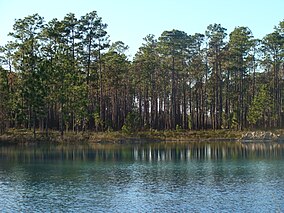Apalachicola National Forest
| Apalachicola National Forest | |
|---|---|
 | |
| Location | Florida, USA |
| Nearest city | Tallahassee, FL |
| Coordinates | 30°14′10″N 84°39′56″W / 30.23611°N 84.66556°W |
| Area | 632,890 acres (2,561.2 km2)[1] |
| Max. elevation | 184 ft. (56 m): 30.4326, -84.3855 |
| Created | May 13, 1936[2] |
| Governing body | U.S. Forest Service |
| Website | Apalachicola National Forest |
The Apalachicola National Forest is the largest
Apalachicola National Forest contains two Wilderness Areas:
Hunting and fishing
Hunting and fishing are monitored and governed by the Florida Fish and Wildlife Conservation Commission (FWC). The national forest itself is a wildlife management area. The FWC divides the management area into sections that allow dog hunting, still hunting, and private property. Modern gun season for large game starts Thanksgiving weekend and ends in January.[4]
The Apalachicola National Forest also manages the Chipola Experimental Forest in Calhoun county in cooperation with the FWC,[5] for youth hunting.[6]
Environment
The Apalachicola National Forest is in the
Near the floodplains of spring-fed rivers grow southern coastal plain hydric hammocks, dense forests of evergreen and deciduous hardwood trees. Blackwater rivers support southern coastal plain blackwater river floodplain forests of baldcypress (Taxodium distichum) along their banks. Major rivers support diverse east Gulf coastal plain large river floodplain forests.[7]
Notable animals that inhabit this forest are red-cockaded woodpecker, fox squirrel, red fox, raccoon, gray fox, bobcat, coyote, black bear, wild turkey and alligator.
It is also home to several wetland plant communities.
The Forest contains thousands of acres of
Gallery
-
Hunters listening for the direction of dogs following the scent of awhite tail deer
-
An artificial pond off of FH-111
-
Silver Lake Recreation Area, a part of the Apalachicola National Forest, about 8 miles (13 km) from Tallahassee, Florida, in 2007
-
Trout Pond Recreation Area, a part of the Apalachicola National Forest, about 6 miles (9.7 km) south of Tallahassee
-
This image shows a large area burned by a forest fire, which appears as dark pink ring-shaped patch at the left side of the image
-
An unimproved road in the Wildlife Management Area off of Hwy. 67
-
Sign warning vehicles to remain on numbered forest roads
See also
References
- ^ a b "Land Areas of the National Forest System" (PDF). U.S. Forest Service.
- ^ Proclamation 2169, 49 Stat. 3516 (May 13, 1936).
- ^ "Apalachicola National Forest".
- ^ "Florida Fish and Wildlife Conservation Commission". Archived from the original on 2011-10-21. Retrieved 2007-12-11.
- ^ Hoyle, Zoë (12 June 2014). "The Chipola Experimental Forest". United States Forest Service Southern Research Station. Archived from the original on 2020-11-21. Retrieved 21 November 2020.
- ^ "Juniper Creek Wildlife Management Area". Florida Fish and Wildlife Conservation Commission. Archived from the original on 2020-11-21. Retrieved 21 November 2020.
- ^ a b c "Land Cover Viewer - Map". National Gap Analysis Program. United States Geological Survey. Archived from the original on 19 February 2013. Retrieved 10 February 2013.
- ^ Mary Byrd Davis (23 January 2008). "Old Growth in the East: A Survey. Florida" (PDF). Archived from the original (PDF) on 26 February 2009. Retrieved 2008-12-31.








